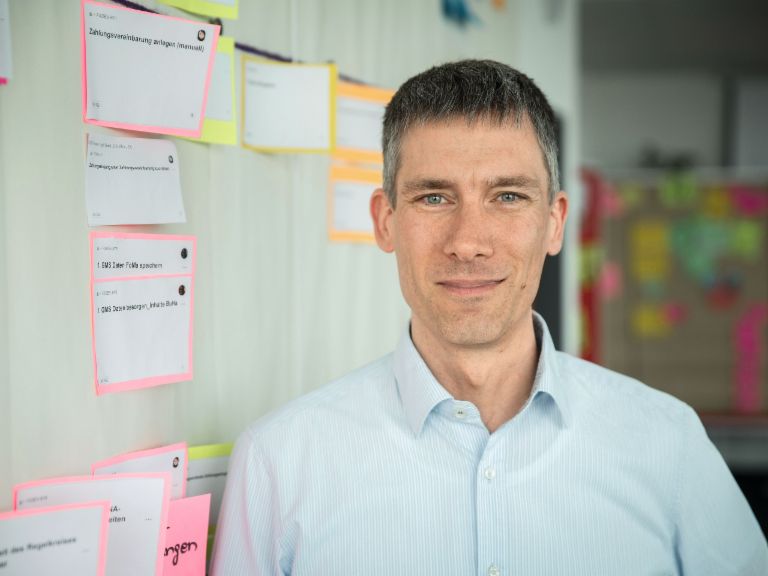More than a buzzword: Why EOS is turning to Agile Software Development.
If you work in a rapidly changing market your business software needs to keep up with the pace. That's why EOS has adopted agile methods to develop its new debt management software - and transform the whole organization along while they're at it.

‘Agile by nature’ is printed on the blue-coloured sticker on Kirsten Hunder's notebook. Next to it on her desk: a set of Lego bricks, juggling balls and coconut pralines. Hunder works at the FX software project of EOS in Hamburg and she knows that the notebook sticker actually sends the wrong message.
‘”The concept of agile is pretty new to me,” says Hunder, who joined FX two years ago. “Thinking in weeks instead of months and managing my time around meetings was a huge change for me.” In her last job, Hunder says, experts withdrew to quiet corners to write 100-page concepts that took 18 months to be implemented. “If you were lucky it was approved, but quite often it was rejected and you had to start all over again.” So Hunder took a while to acclimatise to agile working. ‘Initially, I was sceptical about the merits of table football and all those post-it notes and stickers on the walls, wondering: When do they actually work?’
Today Kirsten Hunder is a product owner and part of a team dubbed ‘KoRn’, merging the German words for communication and reporting, while echoing the name of the German grain spirit. The group of seven people shares an entire floor with four other teams of similar size and similarly quirky names, all in an office block in Hamburg’s City centre.

The mission of the 70-odd colleagues at the FX software developing project is no less than to create the new backbone of EOS in Germany: A completely new software platform for managing receivables. Instead of the current system that communicates with debtors in a highly automated way along rigid guidelines, the FX team is building a more flexible, data-driven platform that aims to treat debtors with respect, while increasing chances that outstanding payments will be made.
“We are analysing anonymised debtor-data, which helps us to find the most effective way to enter a dialogue with the party liable, whether it is via e-mail, WhatsApp or the old-fashioned letter”, says Thomas Lieder of EOS Technology Solutions and Agile Coach at FX, standing in the kitchen and entertainment area with a play station in one corner and that football table that Hunder was so sceptical about in the other.
So, why did the FX team adopt this approach to software development? Is EOS just jumping on a bandwagon, vaunting agile project management as the one-size-fits-all-method for more productivity and flexibility?
“Agile is far more than a buzzword,” Lieder says. “Put simply: There's no other way.” EOS like other companies in the digital world is operating in a rapidly changing corporate landscape, raising the chances that a product is already out-of-date when it reaches the market.
‘Responding to change.’ That's one of the four values of the Agile Manifesto drawn up in 2001 by a group of US software developers who felt frustrated about traditional workflows that followed a rigid plan, similarly to Kirsten Hunder when she’d binned 100-page concept in the past. The pillars of the Manifesto are written on a sheet that Lieder and his colleagues taped on a door of their office space.

Close cooperation and transparency.
“The idea that one must first think things through to the end to find the right solution is a fallacy,” Lieder says. Instead the five interdisciplinary FX teams including software developers, user-experience designers and debt collection agents every fortnight draw up a detailed plan to closely cooperate and focus on for the two weeks ahead. “Our teams work on many small systems that interact and together make up the complete platform. It's a bit like a city with a hospital, a police station and a port that constantly exchange people and data.”
The two-week periods, or sprints, end with a sprint review in which team members gather in front of a wall peppered with post-it notes below headers like ‘implementation’ and ‘improvement.’ That way, agile teams are completely transparent about their objectives, helping them to continuously learn from past sprints. To stay with the metaphor: During a review, agile teams discuss whether the police station they're building is equipped well enough to operate as part of the city infrastructure. They look at which parts they should focus on next to improve the exchange of people and data or whether they should rather start building an airport or cycling lane.
And the agile methodology not just about technology and the skills and qualifications to make it work. Another side of the story is setting up guidelines such as ‘individuals and interactions over processes and tools’, another value of the agile manifesto. “The challenge is to convey a whole mind-set”, says Lieder: “Values such as openness, respect, courage and transparency are crucial to make it work.”
In the end agile software development is all about trust. Trust in yourself, other team members, and agile frameworks such as scrum. Trust empowers the team. “Without trust many things simply don't work,” says Lieder. Then he abruptly turns away to help two of his colleagues remove clean cups from the dish washer. “At EOS we say: 'You build it, you run it',” he says, placing a glass in the cupboard. “That means team members are responsible for their work, but also for other things — like emptying a dishwasher.”
Leadership means getting ride of hurdles.
What role does leadership play in this new kind of workplace culture? “While we reject hierarchy, leadership is still necessary, but not in the traditional sense where an employer tells his employees what to do,” Lieder says. It's about creating a framework for self-empowerment, he says. “I also have a team leader, but I don't need his approval for taking holidays. I coordinate that with my team.”
Leadership at EOS also means removing hurdles: “New colleagues have the choice to work with whatever operating system they feel comfortable with: Windows, Mac or Linux,” Lieder says. Breaking up routines can be a challenge. So building up trust is also essential when winning over other parts of the enterprise to think agile, Lieder says, “We must accept that we're part of a bigger organisation that has financial targets.” While there’s still some way to go to change workflows within the whole company and become truly agile, it's a process everybody benefits from, Lieder is convinced.
One key step has already been made: The first version of the new software has been running alongside the existing platform since November 2017 with debt collection agents constantly feeding feedback back to the teams. This success has also changed the way the FX team is viewed by the rest of the company, as Jana Titov, Senior Internal Communications Consultant at EOS, points out: “What struck me was that IT people, who're commonly stuck with the label of being unsociable, are now role models for the rest of the company in terms of team work and making progress.”
And Kirsten Hunder? Working the agile way has certainly won her over. “I've noticed that becoming agile also makes a huge difference in team-building and education: Our new colleagues have been able to take over responsibility within weeks.” And what about table football? Yes, she says with a smile, of course teams talk about private stuff when they enjoy a beverage on Tuesday nights. “But we mostly talk about the latest bug and how we can solve it — it may sound strange, but it’s great fun,” Hunder says. “I really wouldn’t like to turn the clock backward.”
What is Scrum?
In the world of rugby, a scrum (short for scrummage) is a bundle of sweaty, brawny players jostling for the ball with their heads down – looks like chaos, but needs a lot of training! It's the same in project management where scrum is a framework designed for a development team with up to nine people as well as two more colleagues with specific roles: One is the product owner who makes sure the product created meets customer preferences. The other is the scrum master who is responsible for keeping the ‘engine’ of the project running and for removing hurdles. The scrum team reviews its actions on a regular basis, most commonly every two weeks. In these periods, called sprints, developers solve coding tasks selected during sprint planning from a list of feature requests and ideas, called product backlog. The idea being to deliver a product not just once but as a series of iterative releases or product increments- adjusting it better and better to customer requirements without ever claiming perfection, as the backlog will never be empty.
A closely related, but different framework is extreme programming with even shorter sprints and specific ways of organizing the development work.
